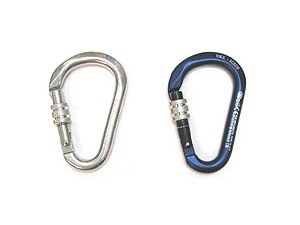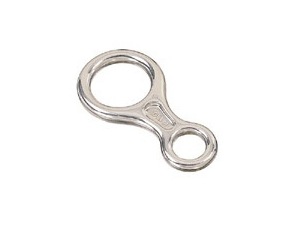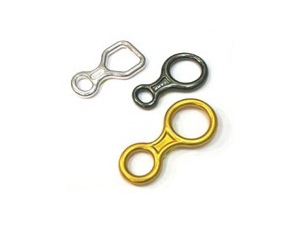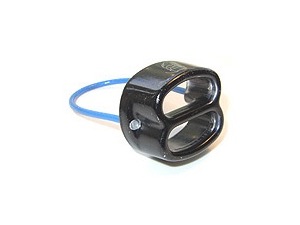Belay device is a tool by which the person providing belay (belayer) controls the rope during fall arrest of the climber. It increases the friction rate of the rope resulting in reducing the amount of total force which the belayer has to hold by the strength of his/hers arms. Belay device therefore facilitates the fall arrest of the climber. Thanks to introduction of belay devices the belaying and fall arrest ceased to be horror activity, as it was in distant past. Today can be belaying done by anybody, even by an older child, providing that everything is done correctly. During belaying must be belay device anchored, either to some fixed point (e.g. belay station with anchoring in the terrain) or to a belayer’s harness (usually connects to the belay loop of the seat harness). There are various designs of belay devices, but basically there are two main types of designs: 1) belay devices without blocking function and 2) with blocking function.
Belay devices without blocking function
These belay devices allows dynamic belay with slip of a rope. With belay devices without blocking function there is one important thing that needs to be mentioned at the start. The breaking done with these belay devices is very low. For a complete stop there is a need for vigorous effort of the belayer. Therefore you should never let go off the rope while belaying with these devices.
HMS carabiner with half hitch
HMS carabiner is simple, effective and high quality belay device. The rope is connected to it by half hitch. Protection with HMS carabiner and half hitch is very safe and thanks to a recommendation of UIAA has been this method labelled “UIAA’s belay method”. HMS carabiner used for protection must have safety lock of the gate. Specially adapted for the purposes of protection is manufactured for example HMS carabiner Belay Master made by DMM. It is fitted with a plastic gate cover, which both effectively prevents accidental opening of carbine, and then also divides the interior space of the carbine into two parts. This will after clipping of carabiner to a belay loop of seat harness or to a belay station fix the carabiner in the desired position, and therefore there cannot be any unwanted rotation and subsequent cross loading of carabiner.

Other belay devices can be generally divided into two large groups – figure 8 rappel devices and tube style devices. Each of these two belay devices have its own principle on which they operate, and the designs of a many of other belay devices are usually variations on theme set by them.

Figure 8 rappel device
Figure 8 was primarily designed as rappelling equipment, but can also be used for protection, and as such is presented by most manufacturers. Disadvantage of figure 8, when used as a belay device, is its small braking effect. This is due to the fact that figure 8, which is intended for rappelling, has dimensions adapted for two strands of rope, because that is used for rappelling the most. But during the belay there is only one strand in the figure 8, and this strand is relatively thin against the size of the eight and radiuses of the rope’s bend are higher, so the friction of the rope on the figure 8 is lower. At the same time there is a rule that the bigger the figure 8 is, the lower braking effect provides, and on the contrary, the smaller figure 8 has a bigger breaking effect, because the rope is bent more. Of course the rappelling on smaller figure 8 is a little bit stiffer. Quid pro quo.

The only advantage of figure 8, when used as a belay device, is the ease of threading of the rope during feeding of the rope to the leader while belaying from the harness, or when retrieving the climber with top rope belay, again in a situation where the belayer is on the ground and belay from the harness.
If you want to belay with figure 8 you need to know how to use it. This belay device does not belong to the hands of a beginner. And even experienced climbers should pay attention when they get their hands on figure 8 that belongs to somebody else and they don’t know it. While arresting a fall the rope can pass through a figure 8 damn fast, and it takes training and experience to surely slow down the rope.
Tube style devices (Sticht plate)
The term “Sticht plate” comes from the first belay device of this design – Sticht plate (created by Austrian mountaineer Franz Sticht). To fully operate it needs to have added carabiner, suitable is HMS carabiner or oval carabiner, in both cases must be used the locking carabiners (must have safety lock of the gate). In this type of belay device is the rope inserted into the opening by bending and through the top of this bending is clipped carabiner preventing slipping of the rope from belay device.

But the shape original Sticht plate is very simple and its options are limited. It was soon followed by modifications of its shape and after a time the shape settled on the form of a short tube with two openings allowing the belay with two-strand rope. In Anglo-Saxon countries is belay device of this shape generally called “tube” or ATC (according to one of the first products of this type made by Black Diamond, which bore the name of Air Traffic Controller), in the Czech Republic is commonly used the name “bucket”. In the latest styles is the basic body of the tube style device specifically profiled, thereby providing the possibility to variably change the amount of braking effect of belay device. This is most often achieved by design of tube walls of different heights, and also by shaping of the groove for the rope into the channel in the shape of the letter “V”, which compresses the free end of the rope, thus achieving greater braking effect. There are many types of tube style devices on the market; we can mention for example the ATC XP (Diamond Black), Hornet (Singing Rock), VCpro (Wild Country), Chuy Tube (Kong), Bug (DMM), SBG II (Omega Pacific).
But the design development was not going only the way of tube style devices. It was continued in maintaining the shape of a plate, but it was enhanced by various profiles and shapes. However, this solution was not very popular. A typical example is belay device Logic by Cassin.
For tube style devices in general applies (similar to the protection with figure 8) that they have relatively little braking effect in arresting the fall directly on the belay station (i.e. in cases that the fall is arrested directly into the belay device).
Continued in the book >>

